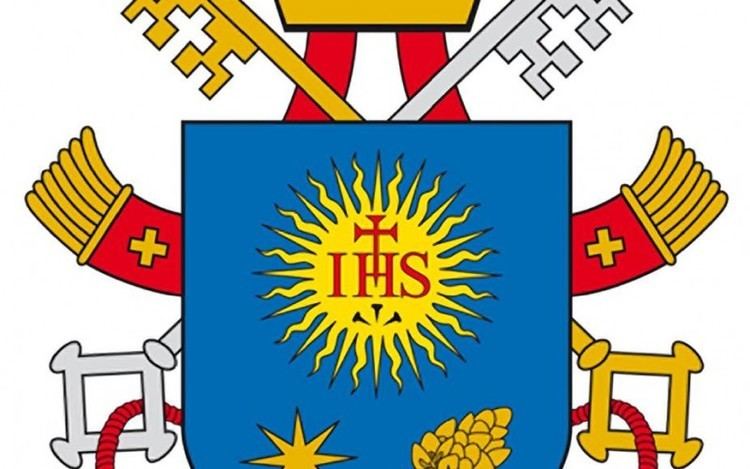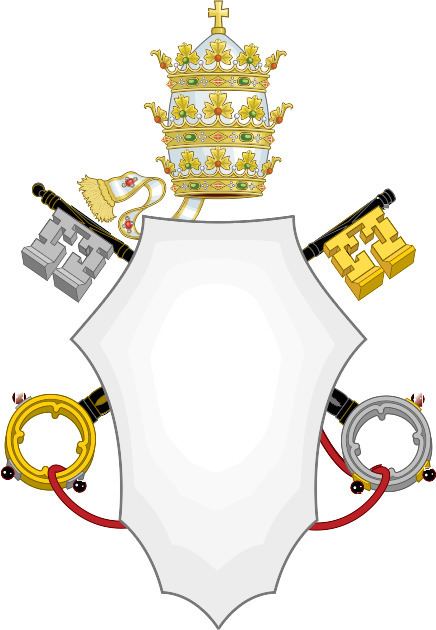 | ||
Papal coats of arms are the personal coat of arms of popes of the Catholic Church. These have been a tradition since the Late Middle Ages, and has displayed his own, initially that of his family, and thus not unique to himself alone, but in some cases composed by him with symbols referring to his past or his aspirations. This personal coat of arms coexists with that of the Holy See.
Contents

Although Pope Boniface VIII (1294-1303), Pope Eugene IV (1431-1447), Pope Adrian VI (1522-1523) and a few others used no crest above their escutcheon, from Pope John XXII (1316-1334) onward the papal tiara began to appear (a custom maintained until Pope Nicholas V) and, from the time of Nicholas V's successor, Pope Callistus III (1455-1458), the tiara combined with the keys of Peter.

Even before the early modern period, a man who did not have a family coat of arms would assume one upon becoming a bishop, as men did when knighted or on achieving some other prominence. Some who already had an episcopal coat of arms altered it on being elected to the papal throne. The last pope who was elected without already being a bishop was Pope Gregory XVI in 1831 and the last who was not even a priest when elected was Pope Leo X in 1513.

In the 16th and 17th century, heraldists also made up fictitious coats of arms for earlier popes, especially of the 11th and 12th centuries. This became more restrained by the end of the 17th century.

High Middle Ages
Heraldry developed out of military insignia from the time of the First Crusade. The first papal coats of arms appeared when heraldry began to be codified in the 12th to 13th centuries. At first, the popes simply used the secular coat of arms of their family. Thus, Pope Innocent IV (1243-1254), who was born Sinibaldo Fieschi, presumably used the Fieschi coat of arms, as did Adrian V (Ottobon de Fieschi), the nephew of Innocent IV.
It is possible that already some 13th-century popes used their secular coat of arms during their papacy: According to Michel Pastoureau, Pope Innocent IV (1243-1254) is likely the first who displayed personal arms, but the first of whom a contemporary coat of arms survives is Pope Boniface VIII (1294-1303). Some sources also indicate family arms (not attributed arms) of the popes of the second half of the 12th century; thus, editions of the Annuario Pontificio of the 1960s presented the arms of the popes beginning with Pope Innocent III (1198-1216), and John Woodward gave those of the popes from Pope Lucius II (1144-1145) onward. Thus, Innocent III (Lothaire de Segni, 1160-1216) and Gregory IX (Ugolin de Segni, 1145-1241) may have used the coat of arms of the Counts of Segni.
The following papal coat of arms should be considered traditional, lacking contemporary attribution. For the popes of noble families, the coats of arms of the family is substituted, and for commoners, the traditional coat of arms as shown in early modern heraldic sources.
Popes of the Early Modern period
Most popes of the 16th to 18th centuries came from Italian noble families, but there were some exceptions. Sixtus V (1585-1590) was born Felice, son of Pier Gentile (also known as Peretto Peretti), into a poor family. He later adopted Peretti as his family name in 1551, and was known as "Cardinal Montalto". His coat of arms was D'azur au lion d'or armé et lampassé de gueules tenant un rameau d'or à la bande de gueules chargée en chef d'une étoile d'or et en pointe d'un mont à trois cimes d'argent.
Popes of the modern period
The last person elected as pope who was not already an ordained priest or monk was Leo X (Giovanni di Lorenzo de' Medici) in 1513. Thus, throughout the Early Modern period, the elected pope already had a coat of arms: if he did not have a family coat of arms to begin with, he would have adopted one upon being made bishop. Upon his election as pope, he would continue using his pre-existing coat of arms. This tradition was continued into the modern period, with the sole exception of Joseph Ratzinger, who upon being elected as Benedict XVI in 2005 adopted a new coat of arms based on the earlier coat of arms he used as a bishop.
